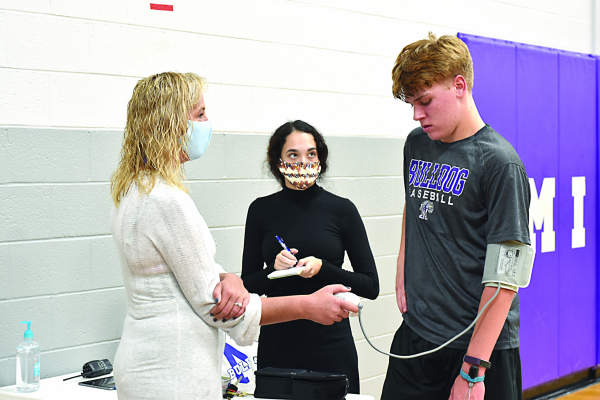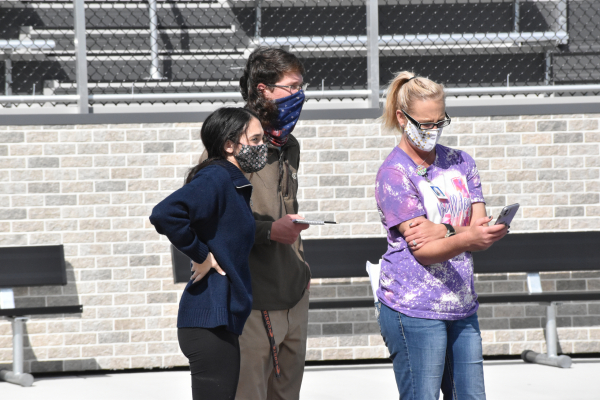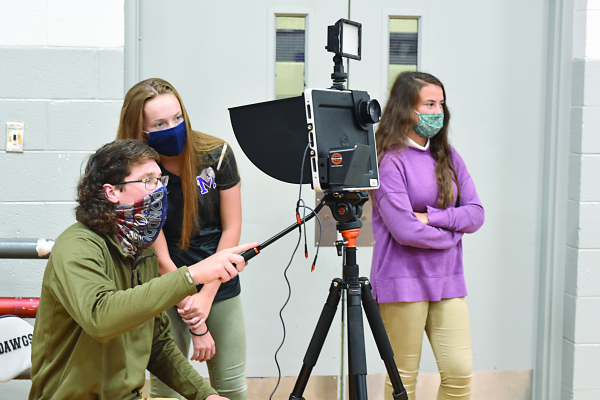Milan High School in West Tennessee began the school year in-person in August of 2020. It felt like a relief to resume some normalcy after the school had closed its doors in March due to COVID-19. Amid the modifications necessary to conduct safe in-person learning was the need for clinical interns in the Health Science program to stay on school grounds.
Local health care facilities restricted access. The fourth-year nursing students had anticipated the internships. Instructor Amy Watson began to search for a project that would give the students a learning experience and still operate within the scope of restrictions and safety requirements.
As in most Tennessee high schools, sports play an integral part in the community culture. Watson’s son plays football, basketball and baseball. As they discussed the importance of nutrition for an athlete’s performance, she found an idea for a project.
Nursing students gained clinical experience working with student athletes.
Using various medical tools and equipment, the interns measured the vital signs of athletes. Then then discussed and applied the data to develop recommendations for better, stronger conditioning.
The interns requested a 24-hour food and drink log from the athletes. They then used a tools to record data from athletes at rest and during practice: a portable EKG, sleep apnea monitor, mechanical blood pressure machine, temperature and humidity gauge, and a pedometer.

With the consent of the first athlete, interns measured:
- Heart rate
- Stressed heart rate
- Respiratory accommodation
- Height
- Weight
- Hydration status
- Blood pressure
- Temperature
Interns recorded athletes during practice in order to track performance. Monitored students averaged 700 steps in 10 minutes. Athletes’ exertion led to a decrease in pulse oximeter readings and an increase in heart rate. Interns gained value experience from this opportunity to witness a visible decrease in energy.
They calculated caloric needs based on measurements and reviewed the food log to determine the presence of macronutrients.
Intern Jack Nelson explained. “Overall food intake should consist of 10–35% protein, 45–65% carbs, and 25–35% fats. We consistently reviewed food logs containing 75–80% carbs from chips, cookies, and fries. The water intake was insufficient as well. Most of the logs showed us the average student drinks less than 30 ounces of water a day.”
“The athletes were burning up all their energy and hydration in a very short amount of time,” said Watson.
Interns studied the marching band practice field as well and found the same results.
Intern Mary Eschbach explained. “We tested a flute player during a 10-minute practice session on the field. As her respiratory drive went up, her heart rate went almost as high as the basketball player’s during practice.”
CTE students developed partnerships to spread nutrition awareness.
Word spread quickly about the project when the interns showed up at athletic practices with their video camera, tools and notepads. The athletes wanted to participate. The next step, the interns realized, led them to Milan High School’s family and consumer sciences (FCS) program.
Veteran FCS teacher Rebecca Jones was thrilled to hear about the interns’ project. One of her classes, Nutrition Across the Lifespan, could use this data to build meal plans to increase athletic performance.

“Nutrition students will keep a personal daily food journal,” said Jones. “This will be used to calculate nutritional deficiencies that can cause health issues — short-term and long-term — related to physical stamina, sleep, emotional disorders, academic performance and overall health.
“From their findings, students will be encouraged to read food labels and make better food choices. Students will practice high-protein, healthy food preparations such as energy bites, granola bars and fresh fruit smoothies.”
Football coaches have long seen the value, choosing protein-packed pre-game meals and emphasizing hydration. But equipping the athletes with their own personalized data adds relevance and meaning to the coaches’ requests.
Students made real-world connections to learning.
School Principal Greg Scott shared his excitement for the program. “The information resulting from the time and effort of this project by Mrs. Watson and her students has phenomenal potential. Coaches, trainers, strength and conditioning coordinators, and even parents and students have the opportunity to use real data to make decisions that can benefit the physical and mental health of our student-athletes. I am excited about the partnership formed between the athletic department and our health science program at Milan High School.”
The interns created a documentary of their learning experiences. Adding interviews with coaches and administrators, the interns brought attention to the eating habits of teenagers and their effects on performance. The documentary is currently being edited and will be released on all Milan Special School District social media sites upon completion.

When asked about his favorite part of the project, Nelson reflected, “I liked taking vital signs and working with the students as patients, taking EKGs and other measurements and understanding what that means. I want to join the military to work in the medical field, and this experience will help.”
Watson took a situation like the COVID-related restrictions and created a project that has been meaningful to many of our students. The icing on the cake is that the community sees what we do in connection with Friday night lights. This goes far beyond a traditional classroom project. This isn’t a book report. This is an experience that could change the habits of our students for the better.
Candi Collier is the CTE director at Milan Special School District with 20 years of experience in CTE. Email her.






